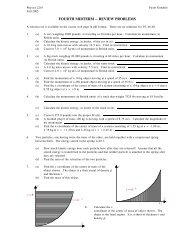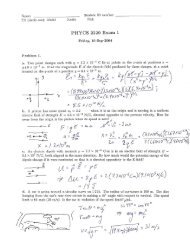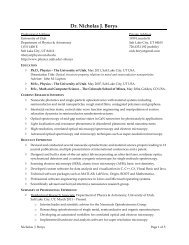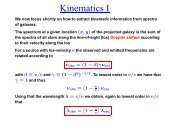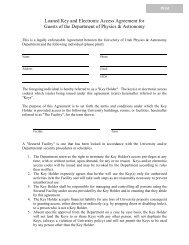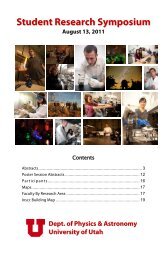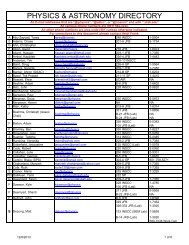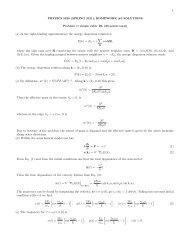Exam 1 Review
Exam 1 Review
Exam 1 Review
You also want an ePaper? Increase the reach of your titles
YUMPU automatically turns print PDFs into web optimized ePapers that Google loves.
Physics 2020 Summer 2011<br />
Richard Ingebretsen<br />
REVIEW FOR MIDTERM 1<br />
1. A 2.00 m long tube is open at both ends. The frequency of a certain harmonic is 410.0 Hz, and the<br />
frequency of the next higher harmonic is 492.0 Hz. Determine the speed of sound in the air column.<br />
2. At rest, a car's horn sounds the note A (440.0 Hz). The horn is sounded while the car is moving down the<br />
street. A bicyclist moving in the same direction with 1/3 the car's speed hears a frequency of 414.0 Hz.<br />
(Speed of sound = 343 m/s)<br />
A. How fast is the car moving?<br />
B. Is the cyclist ahead or behind the car?<br />
3. A. Two loud speakers are placed above and below one another as shown. They are driven<br />
by the same source at a frequency of 500.0 Hz. (V sound = 343 m/s)<br />
1. What minimum distance should the top speaker be moved toward A in order to<br />
create destructive interference between the two speakers?<br />
2. If the top speaker is moved back twice the distance calculated in part (1) above,<br />
will constructive or destructive interference occur?<br />
B. On a work day, the average decibel level of a busy street is 70.0 dB with 100 cars<br />
passing by a given point every minute. If the number of cars is reduced to 25 every<br />
minute on a weekend, what is the new decibel level?<br />
4. A stretched string fixed both ends has a mass of 40.0 g and length of 8.0 m. The tension in the string is<br />
49.0 N.<br />
A. Determine the positions of all the nodes and antinodes for the third harmonic as measured from<br />
one of the fixed ends.<br />
B. What is the vibration frequency for this harmonic?<br />
5. An ambulance is traveling toward a truck. Both the ambulance and truck are traveling at the same speed.<br />
The truck sounds its horn (f = 508.0 Hz). The ambulance driver hears the truck’s horn as 542.0 Hz. The<br />
speed of sound in air is 343.0 m/s. How fast is each going?<br />
6. A weird phenomena occurs when wind blows across a power line. A standing wave is set up much like on<br />
a guitar string which produces a rumbling sound. Assume that a power line (: = .002 kg/m) has a tension<br />
of 323.0 N, and the poles are 19.0 m apart. The lowest frequency that a human ear can hear is 20.0 Hz.<br />
What is the lowest harmonic number n that could be responsible for this low rumbling sound?<br />
7. (a) The external auditory canal (in addition to being a storage place for earwax) serves to increase the<br />
ear’s sensitivity to sound. The canal is about 2.5 cm long and regarded as a tube open at one end<br />
and closed at the eardrum. Around what frequency is the human ear sensitized to by this method<br />
(speed of sound: 343.0 m/s).<br />
(b) What is the length required for an organ pipe to produce a sound of this frequency [from (a)]? The<br />
pipe is open at both ends (the speed of sound is 343.0 m/s).<br />
8. A. The human ear can detect differences in sound intensities as small a 1.0 dB. What is the ratio of<br />
the sound intensities.<br />
B. The human ear can hear “beats” when two sounds are playing on slightly different frequencies. If<br />
two sounds have wavelengths of 0.776 and 0.769 n, what beat frequency is heard? The speed of<br />
sound is 343 m/s.
9. An ambulance siren emits a note of 500 Hz when at rest. Take v sound = 343 m/s.<br />
A. When the ambulance is moving at 10.0 m/s, what frequency is heard by an observer traveling at<br />
15.0 m/s toward the source?<br />
B. When the ambulance is moving at 10.0 m/s, what frequency is heard by an observer traveling at<br />
15.0 m/s after the observer has passed the ambulance and recedes from it?<br />
10. A. Two identical mandolin strings under 200 N of tension are sounding tones with fundamental<br />
frequencies of 523 Hz. The peg of one string slips slightly and the tension in it drops to 196 N.<br />
How many beats are heard each second?<br />
B. You are sitting on the coast of Mombasa, Kenya listening to the sounds of pregnant Anopheles<br />
mosquitos ready to infect you with malaria. You know that a typical sound level for this mosquito<br />
is 40 dB, and normal conversation as approximately 50 dB. How many buzzing Anopheles<br />
mosquitoes will produce a sound intensity equal to that of normal conservation?<br />
11. A 0.30 g wire is stretched between two points 70.0 cm apart. If the tension in the wire is 600 N, find the<br />
wires first, second and third harmonics.<br />
12. A. Two eagles fly directly toward one another, the first at 15.0 m/s and the second at 20.0 m/s. Both<br />
birds screech, one emitting a frequency of 3200 Hz and the other at 3800 Hz. What frequency do<br />
they receive if the speed of sound is 330 m/s?<br />
B. If a large horsefly 3.0 m away from you makes a noise of 40.0 dB, what is the noise level of 1000<br />
flies at that distance?<br />
13. A crude approximation of voice production is to consider the breathing passages and mouth to be a<br />
resonating tube closed at one end.<br />
(a)<br />
What is the fundamental frequency if the tube is 0.240 m long.<br />
Boltzmann's constant = 1.38 × 10 -23 J/K<br />
Mass of helium (M He ) = 3.32 × 10 -27<br />
air temperature = 37.0°C kg; ( = 1.4<br />
14. A. Twenty violins playing simultaneously with the same intensity combine to give an intensity level<br />
of 82.5 dB.<br />
(a) What is the intensity level of each violin?<br />
(b) If the number of violins is increased to 40, will the combined intensity level be more than,<br />
less than or equal to 165 dB? Explain.<br />
B. To tune middle C on a piano, a tuner hits the key and at the same time sounds a 261 Hz tuning<br />
fork. If the tuner hears 3 beats per second, what are the possible frequencies of the piano key?<br />
15. Two cars traveling with the same speed move directly away from one another. One car sounds a horn<br />
whose frequency is 205 Hz and a person in the other car hears a frequency of 192 Hz. What is the speed of<br />
the cars?<br />
16. A 12.5 g clothesline is stretched with a tension of 22.1 N between two poles 7.66 m apart.<br />
(a)<br />
(b)<br />
(c)<br />
(d)<br />
(e)<br />
What is the frequency of the fundamental?<br />
What is the frequency of the second harmonic?<br />
If the tension in the clothesline is increased, do the frequencies in parts (a) and (b) increase,<br />
decrease, or stay the same?<br />
Will the frequencies increase, decrease, or stay the same if a more massive rope is used?<br />
The mass of the clothesline is changed to 15.0 g. Repeat (a) through (d) above using this new<br />
mass.
17. An open organ pipe (open at both ends) has a harmonic with a frequency of 440 Hz. The next higher<br />
harmonic in the pipe has a frequency of 528 Hz.<br />
(a)<br />
(b)<br />
Find the frequency of the fundamental.<br />
What is the length of the pipe?<br />
18. An organ pipe (A), which is open at both ends, is playing its 2 nd harmonic. The wavelength of the 2 nd<br />
harmonic is 0.1000 m Another organ pipe (B), which is closed at one end, is playing its 3 rd harmonic. The<br />
wavelength of the 3 rd harmonic is 0.09968 m. The speed of sound is 343 m/s in both pipes.<br />
(a)<br />
(b)<br />
(c)<br />
Draw the standing wave pattern in each of the tubes and identify at least one node and antinode in<br />
each drawing.<br />
What is the length of each pipe?<br />
What is the beat frequency heard when both pipes play at the same time?<br />
19. An ambulance is traveling with its siren on. Initially you are standing still and observe a frequency of 0.9<br />
times the frequency as compared to what the driver of the ambulance hears. v sound = 343 m/s.<br />
(a)<br />
(b)<br />
(c)<br />
Is the ambulance moving towards you or away from you?<br />
What is the speed of the ambulance?<br />
You later begin to run in the opposite direction as the ambulance at a speed of 3.0 m/s. What<br />
frequency do you hear now if the siren has a frequency of 900 Hz?<br />
20. At a concert you are standing 4.0 m away from a speaker and hear the music at 120 dB. (Note: The<br />
threshold of human hearing is at an intensity of 10 -12 W/m 2 .)<br />
(a)<br />
(b)<br />
(c)<br />
Assuming the sound of the speaker moves outward in all directions, what is the power of the<br />
speaker?<br />
How far away from the speaker should you stand to listen to the music at a more safe 80 dB?<br />
If there were 3 identical speakers with the same power output as found in part (a) and you stand<br />
4.0 m away, how many decibels do you hear the music playing at?<br />
21. A guitar string has a tension of 80 N and has a mass of 6.0 g and is 0.4 m<br />
long.<br />
(a)<br />
(b)<br />
(c)<br />
What is the speed of a wave on this string?<br />
What is the fundamental frequency of this string?<br />
Two identical guitars, as described above, play a note in phase<br />
at their fundamental frequencies. If the guitars and a listener<br />
are positioned as shown in the drawing, what is the largest<br />
possible distance (d), such that the listener hears no sound?<br />
(Note: The speed of sound in air = 343 m/s.)<br />
22. Farid plays a banjo at the top of a round well that is open to the air. He<br />
plucks a string at its fundamental frequency (mass = 5.0 grams; length = 0.40 m; tension = 125 N) and<br />
notices that the sound seems louder than usual. This phenomena happens again when he plucks another<br />
string at its fundamental frequency (mass = 4.0 grams; length = 0.40 m; tension = 196 N). It happens yet<br />
again when he plays a note at that produces a frequency of 225 Hz. Speed of sound = 343 m/s<br />
(a)<br />
(b)<br />
(c)<br />
(d)<br />
What is the wavelength of the 2nd harmonic on the 5.0 gram string?<br />
How deep is the well?<br />
Find the fundamental frequency of the well.<br />
Calculate the wavelength of the fundamental frequency of the well.
23. A rocket in a fireworks display explodes high in the air. The sound spreads out uniformly in all directions.<br />
Eric is standing 150 m away from the explosion and observes the intensity of the sound to be 2.0 W/m 2 .<br />
Elliot is standing at a different location that is 100 m away from the explosion. The threshold of human<br />
hearing is 1 × 10 -12 W/m 2 .<br />
(a)<br />
(b)<br />
(c)<br />
(d)<br />
What intensity level does Eric hear?<br />
What is the power of sound produced by the explosion?<br />
What the intensity level does Elliot hear?<br />
An intensity level of 180 dB causes irreversible damage to the ears including hearing loss. How<br />
close to the explosion would Elliot have to be to suffer this type of injury?<br />
24. Two trains are traveling in opposite directions on parallel tracks. Train A is heading east and sounds its<br />
horn at a frequency of 1000 Hz. Train B is traveling west at 30 m/s and is also sounding its horn. Speed of<br />
sound in air = 343 m/s<br />
(a)<br />
(b)<br />
(c)<br />
(d)<br />
Josh is standing by the tracks as both trains are heading towards him. He observes a frequency of<br />
1050 Hz coming from train A, how fast is it moving?<br />
Josh observes a frequency of 1200 Hz coming from train B as it is approaching him. What<br />
frequency does the conductor of train B hear coming from his own train?<br />
As the two trains are approaching one another, what frequency does the conductor of train A hear<br />
coming from train B?<br />
After the two trains have passed each other and are now moving away from each other, what<br />
frequency does the conductor of train B hear coming from train A?<br />
25. Standing waves are set up on three strings fixed at each end at their fundamental<br />
frequencies, as shown in the drawing. The tensions in the strings are the same<br />
and all strings have the same linear density. However, their lengths vary.<br />
For parts a-c, circle the correct answer:<br />
(a)<br />
(b)<br />
(c)<br />
The waves on the string B have a (larger speed, same speed, smaller<br />
speed, not enough information to tell) compared to those on string A.<br />
String B vibrates at (a higher frequency, the same frequency, a lower<br />
frequency, not enough information to tell) compared to string A.<br />
The beat frequency produced by the two standing waves on strings C<br />
and A will be (greater than, the same as, less than, not enough<br />
information to tell) the beat frequency produced by strings B and A.<br />
As stated above, all strings have the same linear density and tension. String A has a fundamental frequency<br />
of 210 Hz. The speed of the waves on string A is 42 m/s. String B is 0.60 cm longer than string A. String<br />
C is 1.20 cm longer than string A.<br />
(d) What is the frequency of a wave on string C?<br />
(e) What is the beat frequency between strings B and A?<br />
26. A If an ocean wave hits a particular beach once every four seconds and the wave peaks are 12 m<br />
apart, what is the velocity of the waves coming into shore?<br />
(a) 3 m/s (b) 4 ms/ (c) 12 m/s (d) 48 m/s<br />
B. Sound waves are an example of<br />
(a)<br />
(b)<br />
(c)<br />
(d)<br />
longitudinal waves because the medium moves perpendicularly to the propagation of the<br />
wave.<br />
longitudinal waves because the medium moves parallel to the propagation of the wave.<br />
transverse waves because the medium moves perpendicularly to the propagation of the<br />
wave.<br />
transverse waves because the medium moves parallel to the propagation of the wave.
C. If a guitar string is 0.5 m long, what is the wavelength of its third harmonic?<br />
(a) 0.25 m (b) 0.33 m (c) 0.5 m (d) 1 m<br />
D. Two violinists are playing together and are slightly out of tune. If one violinist produces a<br />
frequency of 883 Hz and the other produces a frequency of 879 Hz, the frequency of the beats<br />
heard would be<br />
(a) 2 Hz (b) 4 Hz (c) 81 Hz (d) 1762 Hz<br />
E. Two waves are traveling toward each other on the same string. Wave A has an amplitude of 3 cm<br />
and a wavelength of 10 cm, and wave B has an amplitude and wavelengths twice that of wave A.<br />
What is the maximum displacement of the string when the waves interfere with each other?<br />
(a) 0 cm (b) 3 cm (c) 6 cm (d) 9 cm<br />
F. A vibrating string has consecutive harmonics at wavelengths of 2.0 m and 4.0 m. What is the<br />
length of the string?<br />
(a) 1.0 m (b) 2.0 m (c) 4.0 m (d) 8.0 m<br />
27. A guitar string has a tension of 100 N and has a mass of 7.0 g and is 0.45 m long. speed of sound in air =<br />
343 m/s<br />
(a)<br />
(b)<br />
(c)<br />
What is the speed of a wave on this string?<br />
What is the frequency of the third harmonic on this string?<br />
Two identical guitars, as described above, play a note in phase<br />
at their fundamental frequencies. If the guitars and a listener are<br />
positioned as shown in the drawing, what is the largest possible<br />
distance (d), such that the listener hears no sound?<br />
28. A rocket in a fireworks display explodes high in the air. The sound<br />
spreads out uniformly in all directions. Aaron is standing 150 m away from the explosion and observes the<br />
intensity of the sound to be 2.0 W/m 2 . Justin is standing at a different location and observes the intensity<br />
level to be 90 dB. threshold of human hearing is 1 × 10 -12 W/m 2<br />
(a)<br />
(b)<br />
(c)<br />
(d)<br />
What intensity level does Aaron hear?<br />
What is the power of sound produced by the explosion?<br />
How far away from the explosion is Justin?<br />
An intensity level of 180 dB causes irreversible damage to the ears including hearing loss. How<br />
close to the explosion would Justin have to be to suffer this type of injury?<br />
29. Two trains are traveling in opposite directions on parallel tracks . Train A is heading east and sounds its<br />
horn at a frequency of 1000 Hz. Train B is traveling west at 30 m/s and is also sounding its horn.<br />
speed of sound in air = 343 m/s<br />
(a) When both trains are headed towards each other the conductor of train A observes a frequency of<br />
1200 Hz coming from train B. Farid is standing by the tracks as both trains are heading towards<br />
him. Both trains sound their horns and Farid observes a beat frequency of 15 Hz. How fast is<br />
train A moving?<br />
(b) What beat frequency does Farid hear when both trains are traveling away from him?<br />
speed of sound in air = 343 m/s
30. A The speed of a transverse wave on a string is 470 m/s, and the wavelength is 0.13 m. The<br />
amplitude of the wave is 1 mm. How much time is required for a particle of the string to move<br />
through a total distance of 1.0 km? This distance is accomplished by the particle moving up and<br />
down only.<br />
B. A wire is stretched between two posts. Another wire is stretched between two posts that are four<br />
times as far apart. The tension in the wires is the same, and they have the same mass. A<br />
transverse wave travels on the shorter wire with a speed of 200 m/s. What would be the speed of<br />
the wave on the longer wire?<br />
C. The drawing shows two graphs that<br />
represent a transverse wave on a string.<br />
The wave is moving in the +x direction.<br />
(a)<br />
(b)<br />
What is the amplitude of the<br />
wave?<br />
What is the speed of the wave?<br />
D. An amplified guitar has a sound intensity level that is 16 dB greater than the same unamplified<br />
sound. If the unamplified sound has an intensity of 10 -6 W/m 2 , what is the amplified intensity?<br />
31. A. Inside a busy restaurant, a small mouse is dancing around. Assume the noise it makes has a power<br />
of 0.042 W and radiates uniformly outward in all directions. How much power goes into<br />
one ear (area = 2.1 × 10 -3 m 2 ) of a person sitting 10 m away from the mouse?<br />
B. A tube is open only at one end. A certain harmonic produced by the tube has a frequency of 495<br />
Hz. The next higher harmonic has a frequency of 825 Hz. The speed of sound in air is 343 m/s.<br />
(a)<br />
(b)<br />
What is the integer n that describes the harmonic whose frequency is 495 Hz?<br />
Find is the length of the tube.<br />
C. In the figure, suppose that the separation between speakers A and B is 7.00 m and the<br />
speakers are vibrating in phase. They are playing identical 135 Hz tones, and the speed of<br />
sound is 343 m/s. The observer starts from 300 m away from speaker B at a point C and<br />
walks in a straight line toward speaker B. How far away is he from speaker B when he<br />
comes to the second spot where he hears no<br />
sound?<br />
32. A. At a concert you are standing 4.0 m away from a speaker and hear the music at 120 dB. (Note:<br />
The threshold of human hearing is at an intensity of 10 -12 W/m 2 .)<br />
(a)<br />
(b)<br />
(c)<br />
Assuming the sound of the speaker moves outward in all directions, what is the power of<br />
the speaker?<br />
How far away from the speaker should you stand to listen to the music at a more safe<br />
80 dB?<br />
f there were 3 identical speakers with power output of 100 W each and you stand 4.0 m<br />
away, how many decibels do you hear the music playing at?<br />
B. A row of seats is parallel to a stage at a distance of 9.0 m from it. At the center and front of the<br />
stage is a diffraction horn loudspeaker. This speaker sends out its sound through an opening that is<br />
like a small doorway with a width D of 0.073 m. The speaker is playing a tone that has a frequency<br />
of 3.00 × 10 4 Hz. The speed of sound is 343 m/s. What is the separation between two seats,<br />
located near the center of the row, at which the tone cannot be heard?
33. A. The fundamental frequency of a string fixed at both ends is 388 Hz. How long does it take for a<br />
wave to travel the length of this string?<br />
B. A string has a linear density of 8.80 × 10 -3 kg/m and is under a<br />
tension of 265 N. The string is 2.1 m long, is fixed at both ends,<br />
and is vibrating in the standing wave pattern shown in the<br />
drawing.<br />
(a)<br />
(b)<br />
(c)<br />
Determine the speed of the traveling wave.<br />
Find the wavelength of the traveling wave.<br />
Calculate the frequency of the traveling wave<br />
C. You are flying in an ultra-light aircraft at a speed of 44 m/s. An eagle, whose speed is 13 m/s, is<br />
flying directly toward you. Each of the given speeds is relative to the ground. The eagle emits a<br />
shrill cry whose frequency is 3400 Hz. The speed of sound is 330 m/s. [going toward each other<br />
v j 6 7v eg ]<br />
(a)<br />
(b)<br />
What frequency do you hear?<br />
Part of the cry is reflected from the jet and returns to the eagle. What frequency does the<br />
eagle hear for this reflected wave?<br />
34. A The speed of a transverse wave on a string is 470 m/s, and the wavelength is 0.13 m. The<br />
amplitude of the wave is 1 mm. How much time is required for a particle of the string to move<br />
through a total distance of 1.0 km? This distance is accomplished by the particle moving up and<br />
down only.<br />
B. A wire is stretched between two posts. Another wire is stretched between two posts that are four<br />
times as far apart. The tension in the wires is the same, and they have the same mass. A<br />
transverse wave travels on the shorter wire with a speed of 200 m/s. What would be the speed of<br />
the wave on the longer wire?<br />
C. The drawing shows two graphs that<br />
represent a transverse wave on a string.<br />
The wave is moving in the +x direction.<br />
(a) What is the amplitude of the<br />
wave?<br />
(b) What is the speed of the wave?<br />
D. An amplified guitar has a sound intensity<br />
level that is 16 dB greater than the same unamplified sound. If the unamplified sound has an<br />
intensity of 10 -6 W/m 2 , what is the amplified intensity?<br />
35. A. Inside a busy restaurant, a small mouse is dancing around. Assume the noise it makes has a power<br />
of 0.042 W and radiates uniformly outward in all directions. How much power goes into one ear<br />
(area = 2.1 × 10 -3 m 2 ) of a person sitting 10 m away from the mouse?<br />
B. A tube is open only at one end. A certain harmonic produced by the tube has a frequency of 495<br />
Hz. The next higher harmonic has a frequency of 825 Hz. The speed of sound in air is 343 m/s.<br />
(a) What is the integer n that describes the harmonic whose frequency is 495 Hz?<br />
(b) Find is the length of the tube.<br />
C. [9 pts.] In the figure, suppose that the separation between speakers A<br />
and B is 7.00 m and the speakers are vibrating in phase. They are<br />
playing identical 135 Hz tones, and the speed of sound is 343 m/s. The<br />
observer starts from 300 m away from speaker B at a point C and walks<br />
in a straight line toward speaker B. How far away is he from speaker B<br />
when he comes to the second spot where he hears no sound?
36. A. At a concert you are standing 4.0 m away from a speaker and hear the music at 120 dB. (Note:<br />
The threshold of human hearing is at an intensity of 10 -12 W/m 2 .)<br />
(a) Assuming the sound of the speaker moves outward in all directions, what is the power of<br />
the speaker?<br />
(b) How far away from the speaker should you stand to listen to the music at a more safe 80<br />
dB?<br />
(c) If there were 3 identical speakers with power output of 100 W each and you stand 4.0 m<br />
away, how many decibels do you hear the music playing at?<br />
B. A row of seats is parallel to a stage at a distance of 9.0 m from it. At the center and front of the<br />
stage is a diffraction horn loudspeaker. This speaker sends out its sound through an opening that is<br />
like a small doorway with a width D of 0.073 m. The speaker is playing a tone that has a frequency<br />
of 3.00 × 10 4 Hz. The speed of sound is 343 m/s. What is the separation between two seats,<br />
located near the center of the row, at which the tone cannot be heard?<br />
37. A. The fundamental frequency of a string fixed at both ends is 388 Hz. How long does it take for a<br />
wave to travel the length of this string?<br />
B. A string has a linear density of 8.80 × 10 -3 kg/m and is under a<br />
tension of 265 N. The string is 2.1 m long, is fixed at both ends, and<br />
is vibrating in the standing wave pattern shown in the drawing.<br />
(a) Determine the speed of the traveling wave.<br />
(b) Find the wavelength of the traveling wave.<br />
(c) Calculate the frequency of the traveling wave<br />
C. You are flying in an ultra-light aircraft at a speed of 44 m/s. An eagle, whose speed is 13 m/s, is<br />
flying directly toward you. Each of the given speeds is relative to the ground. The eagle emits a<br />
shrill cry whose frequency is 3400 Hz. The speed of sound is 330 m/s. [going toward each other<br />
v j 6 7v eg ]<br />
(a)<br />
(b)<br />
What frequency do you hear?<br />
Part of the cry is reflected from the jet and returns to the eagle. What frequency does the<br />
eagle hear for this reflected wave?<br />
38. A. The mass of a string is 5.6 × 10 -3 kg, and it is stretched so the tension in it is 185 N. A transverse<br />
wave traveling on this string has a frequency of 260 Hz and a wavelength of 0.60 m. What is the<br />
length of the string?<br />
B. Two speakers, one directly behind the other, are in phase and each generating a 245 Hz sound<br />
wave. What is the smallest separation distance between the speakers that will produce destructive<br />
interference at a listener standing in front of them? Assume that the speed of sound is 341 m/s.<br />
C. A 34 cm length of wire has a mass of 6.0 g. It is stretched between two fixed supports and is under<br />
a tension of 185 N. What is the fundamental frequency of this wire?<br />
D. A recording engineer works in a soundproofed room that is 52.0 dB quieter than the outside. If the<br />
sound intensity in the room is 1.40 × 10 -10 W/m 2 , what is the intensity outside?<br />
39. A. Suppose that sound is emitted uniformly in all directions by a public address system. The intensity<br />
at a location 24 m away from the sound source is 2.8 × 10 -4 W/m 2 . If a person is standing 85 m<br />
away, how much energy goes through one ear (area = 0.1 cm 2 ) in 2 hours?<br />
B. Two loudspeakers on a concert stage are vibrating in phase. A listener is 54.5 m from the left<br />
speaker and 27 m from the right speaker. The listener can respond to all frequencies from 20 to<br />
20,000 Hz, and the speed of sound is 343 m/s. What is the third lowest frequency that cannot be<br />
heard at this location, but that can be heard if he moves somewhere else between the speakers?<br />
C. The fundamental frequency of a string fixed at both ends is 388 Hz. How long does it take for a<br />
wave to travel the length of this string?z
40. A. Rich plays a banjo at the top of a round well that is open to the air. He plucks a string at its<br />
fundamental frequency (mass = 5.0 grams; length = 0.40 m; tension = 125 N) and notices that the<br />
sound seems louder than usual. This phenomena happens again when he plucks another string at<br />
its fundamental frequency (mass = 4.0 grams; length = 0.40 m; tension = 196 N). It happens yet<br />
again when he plays a note at a frequency of 225 Hz. Speed of sound = 343 m/s.<br />
1. How deep is the well?<br />
2. Find the fundamental frequency of the well.<br />
B. A speaker on a car produces a frequency of 21 Hz. The speed of sound is 343 m/s. When Bill is<br />
driving toward a brick wall, he hears a beat frequency of 3 Hz caused by the original sound and the<br />
reflected sound from the brick wall. How fast is Bill driving?<br />
41. A. A 3.00 kHz tone is being produced by a speaker with a radius of 0.080 m. The air temperature<br />
changes from 0 to 29°C. Assuming air to be an ideal gas (m = 4.78 × 10 -26 kg, ( = 1.4), find the<br />
change in the diffraction angle 2. for the first minima.<br />
B. Two loudspeakers are vibrating in phase. They are set up as in the figure, and point C<br />
is located as shown there. Assume the speed of sound is 343 m/s. The speakers play<br />
the same tone. What is the second smallest frequency that will produce destructive<br />
interference at point C?<br />
42. A. A person lying on an air mattress in the ocean rises and falls through one complete cycle every 5<br />
seconds. The crests of the wave causing the motion are 20.0 m apart. Determine the speed of the<br />
wave.<br />
B. Suppose that sound is emitted uniformly in all directions by a public address system. The<br />
intensity at a location 20 m away from the sound source is 2.7 × 10 -4 W/m 2 . What is the<br />
intensity at a spot that is 73 m away?<br />
C. A wire is stretched between two posts. Another wire is stretched between two posts that are four<br />
times as far apart. The tension in the longer wire is twice the tension in the shorter wire,<br />
and the wires have the same mass. A transverse wave travels on the shorter wire with a<br />
speed of 210 m/s. What would be the speed of the wave on the longer wire?<br />
D. When a person wears a hearing aid, the sound intensity level increases by 21.0 dB. By what<br />
factor does the sound intensity increase?<br />
43. A. A 2.50 m long tube is open at one end. The frequency of a certain harmonic is 429 Hz, and the<br />
frequency of the next higher harmonic is 495 Hz. Determine the speed of sound in the air column.<br />
B. A hunter is standing on flat ground between two vertical cliffs that are directly opposite one another.<br />
He is closer to one cliff than to the other. He fires a gun and, after a while, hears three echoes. The<br />
second echo arrives 2 s after the first, and the third echo arrives 0.9 s after the second. Assuming<br />
that the speed of sound is 343 m/s and that there are no reflections of sound from the ground, find<br />
the distance between the cliffs.<br />
C. A strange phenomenon occurs when wind blows across a power line. A standing wave is set up<br />
much like on a guitar string which produces a rumbling sound. Assume that a power line with linear<br />
mass density .002 kg/m has a tension of 323.0 N, and the poles are 25.0 m apart. The lowest<br />
frequency that a human ear can hear is 20.0 Hz. What is the minimum number of antinodes that this<br />
wave could have if it is responsible for this low rumbling sound
44. A. In the figure, suppose that the separation between speakers A<br />
and B is 4.60 m and the speakers are vibrating in phase. They<br />
are playing identical 172 Hz tones, and the speed of sound is<br />
344 m/s. What is the closest possible distance between speaker<br />
B and the observer at C, such that he observes destructive<br />
interference?<br />
B. Two cars move directly away from one another. One car sounds a horn whose frequency is 205 Hz<br />
and a person in the other car hears a frequency of 192 Hz. The speed of sound is 343 m/s. The car<br />
which sounds its horn is moving twice as fast as the other car. What is the speed of the slower car?<br />
45. A. Inside a busy restaurant, a small mouse is dancing around. Assume the noise it makes has a power<br />
of 0.042 W and radiates uniformly outward in all directions. How much energy goes into one ear<br />
(area = 2.1 × 10 -3 m 2 ) of a person sitting 10 m away from the mouse in a period of 30 minutes?<br />
B. Speakers A and B are vibrating in phase. They are directly facing each other, are 0.90 m apart, and<br />
are each playing a 686 Hz tone. The speed of sound is 343 m/s. On the line between the speakers<br />
there are locations where constructive interference occurs. What are the distances of these locations<br />
from speaker A?
46. A. Measurements show that the speed of sound in a certain material is 323m/s. A sound frequency of<br />
1500 Hz is applied to the material. Find the wavelength of the sound in the material.<br />
B. An uncomfortably loud sound might have an intensity of 0.54 W/m 2 . If a sound from the speakers is<br />
emitted in all directions at a rock concert and is 1.20 W/m 2 at 5 m from the speakers, how far would a<br />
person have to stand for the sound to be merely uncomfortably loud?<br />
C. Two little boys have stretched a string between their adjacent windows 5 m apart and attached cans to<br />
transmit their voices. The boys do not like that they can hear each other through the window before they<br />
can hear each other through the cans. If the speed of sound in the string is 170 m/s and the speed of sound<br />
in air is 340m/s, by how much do they need to increase the tension in the string (T new /T old ) in order to<br />
match the speed of sound through their windows?<br />
D, When a person wears a hearing aid, the sound intensity level is increased by 19.0 dB. By what factor<br />
does the sound intensity increase?<br />
47. A. A long tube in air is open at both ends. A harmonic frequency is measured at 330 Hz, and the next higher<br />
harmonic is measured at 396 Hz.<br />
1. If the speed of sound in air is 340 m/s in the tube, how long is the tube?<br />
2. What is the fundamental frequency?<br />
B. A sonic device for measuring room size is often employed by appraisers. The device emits short high<br />
pitched sound pulses which bounce off a far wall and are detected by the device. Assume the speed of<br />
sound in air is 340 m/s, and the device detects the echo at 0.06 seconds after emission. How far is the<br />
opposite wall?<br />
C. A strange phenomenon occurs when wind blows across a power line. A standing wave is set up much<br />
like on a guitar string which produces a rumbling sound. Assume that a power line with linear mass<br />
density of 2.50 × 10 -3 kg/m has a tension of 345 N and distance between the poles is 20.0 m. The lowest<br />
frequency the human ear can hear is 20.0Hz. Find the minimum number of antinodes in the wire that<br />
could have produced this low rumbling sound.<br />
48. A. Two sound sources (speakers) in this figure emit sound at the same<br />
frequency and are in phase with each other. Sound source A starts at<br />
position B and is slowly being moved to the left. The listener is 2.50 m<br />
from speaker B. The listener hears the first constructive interference node<br />
at d 1 = 40.0 cm. What is d 1 when the listener hears the second destructive<br />
interference node?<br />
B. A tuning fork of frequency 400 Hz is moved away from a stationary<br />
observer towards a flat wall at a speed of 2.00 m/s. Assume the speed of<br />
sound in air is 340 m/s. What is the beat frequency between the tuning<br />
fork and the reflected sound as heard by the stationary observer?<br />
49. A. A mother is in a car with her child who speaks non-stop for 45 minutes. The mother’s ear is 75 cm from<br />
the child’s mouth. The noise the child makes has a power of 0.50 W and radiates outward in all<br />
directions. How much energy goes into one ear (area = 2.0 × 10 -3 m 2 ) of the mother during the 45<br />
minutes?<br />
B. Two sound sources (speakers) directly face each other and are a distance of 10 m apart. The speakers are<br />
playing identical tones that have 170 Hz. Speed of sound in air is 340 m/s. Along the line between the<br />
two speakers are locations where destructive interference occurs. What are the locations of the<br />
destructive interference from the speaker on the right?
50. A. Tsunamis are fast-moving waves generated by underwater earthquakes. In the deep ocean their amplitude<br />
is barely noticeable, but upon reaching shore, they can rise up to the astonishing height of a six-story<br />
building. One tsunami wave, generated off the Aleutian Islands in Alaska, had a wavelength of<br />
9.0 × 10 2 km and traveled a distance of 3700 km in 5.2 h. Find the period of the wave.<br />
B. Speaker 1 is placed directly behind speaker 2. Each speaker generates a 215 Hz sound wave. A listener<br />
is standing directly in front of the speakers. What is the smallest separation distance between the speakers<br />
that will produce destructive interference? Assume that the speed of sound is 338 m/s.<br />
C. The fundamental frequency of a string fixed at both ends is 373 Hz. How long does it take for a wave to<br />
travel the length of this string?<br />
D. A person hums into the top of a well and finds that standing waves are established at frequencies of 48,<br />
80, and 112 Hz (with no frequencies between these). The frequency of 48 Hz is not necessarily the<br />
fundamental frequency. The speed of sound is 343 m/s. How deep is the well?<br />
51. A. Two cars are both moving in the same direction. Car A is moving twice as fast as car B. The speed of<br />
sound is 343 m/s. Car A sounds a horn (frequency 205 Hz) and a person in the car B hears a frequency of<br />
192 Hz.<br />
1. Car B is ahead of car A. True False (circle one)<br />
2. What is the speed of car A?<br />
B. In the figure, suppose that the separation between speaker B and the<br />
observer is 7.00 m and the speakers are vibrating in phase. They are<br />
playing identical 135 Hz tones, and the speed of sound is 343 m/s.<br />
Speaker A is positioned somewhere to the left of speaker B as shown.<br />
What is the closest distance speaker A can be to speaker B so that the<br />
observer hears no sound?<br />
52. A. Two identical mandolin strings under 200 N of tension are sounding tones with fundamental frequencies<br />
of 523 Hz. The peg of one string slips slightly and the tension in it drops to 196 N. How many beats are<br />
heard each second?<br />
B. You are sitting on the coast of Mombasa, Kenya listening to the sounds of pregnant Anopheles<br />
mosquitoes ready to infect you with malaria. You know that a typical sound level for this mosquito is<br />
40 dB when the mosquito is 2.0 meters away, and normal conversation is approximately 50 dB. How<br />
many buzzing Anopheles mosquitoes will produce a sound intensity equal to that of normal conservation<br />
if the mosquitoes are 8.0 meters away?<br />
C. Speakers A and B are vibrating in phase. They are directly facing each other, are 0.90 m apart, and are<br />
each playing a 686 Hz tone. The speed of sound is 343 m/s. On the line between the speakers there are<br />
locations where constructive interference occurs. What are the distances of these locations from speaker<br />
A?
53. A. During the recent U2 concert, a student could hear the music from his couch at approximately<br />
conversation level (50 dB). The student estimated that he was about a mile away from the concert<br />
(1600 m). Assume the sound from the concert moves outward in all directions and that none of the sound<br />
was blocked by any buildings.<br />
1. What dB level would a concert attendee hear if they were 16 m from source of the sound?<br />
2. If the student heard 50 dB on his couch during the entire 3 hour concert, how much energy was<br />
produced in 3 hours?<br />
B. Johy plays a banjo at the top of a round well that is open to the air. She plucks a string at its fundamental<br />
frequency (mass = 8.0 grams; length = 0.40 m; tension = 200 N) and notices that the sound seems louder<br />
than usual. This phenomena happens again when she plucks another string at its fundamental frequency<br />
(mass = 4.0 grams; length = 0.40 m; tension = 196 N). It happens yet again when she plays a note at that<br />
produces a frequency of 225 Hz. Speed of sound = 343 m/s.<br />
1. What is the wavelength of the 2nd harmonic on the 8.0 gram string?<br />
2. How deep is the well?<br />
54. A. Tsunamis are fast-moving waves generated by underwater earthquakes. In the deep ocean their<br />
amplitude is barely noticeable, but upon reaching shore, they can rise up to the astonishing height of a sixstory<br />
building. One tsunami, generated off the Aleutian Islands in Alaska, had a wavelength of 9.0 × 10 2<br />
km and traveled a distance of 3700 km in 5.2 h. Find the wave's period.<br />
B. Suppose that a public address system emits sound uniformly in all directions and that there are no<br />
reflections. The intensity at a location 24 m away from the sound source is 3.1 × 10 -4 W/m 2 . What is the<br />
intensity at a spot that is 82 m away?<br />
C. Two loudspeakers face each other, vibrate in phase, and produce identical 440 Hz tones. A listener walks<br />
from one speaker toward the other at a constant speed and hears the loudness change (loud-soft-loud) at a<br />
frequency of 2.2 Hz. The speed of sound is 343 m/s. What is the walking speed?<br />
D. To measure the acceleration due to gravity on a distant planet, an astronaut hangs a 0.065 kg ball from the<br />
end of a wire. The wire has a length of 1.5 m and a linear density of 3.10 × 10 -4 kg/m. Using electronic<br />
equipment, the astronaut measures the time for a transverse pulse to travel the length of the wire and<br />
obtains a value of 0.070 s. The mass of the wire is negligible compared to the mass of the ball.<br />
Determine the acceleration due to gravity.<br />
55. A. The sound produced by a mosquito results from its wing beats. The frequency of the wing beat of a<br />
female mosquito (400 Hz) is different from that of a male (600 Hz). This frequency difference is used by<br />
mosquitoes for gender identification. A female and a male mosquito are flying directly toward each other<br />
at the same speed. The male mosquito misidentifies the female for a male. The speed of sound is 334<br />
m/s. How fast are the mosquitoes traveling?<br />
B. In the figure below two in-phase loudspeakers, A and B, are separated<br />
by 10.50 m. Keyton is stationed at point C, which is 2.32 m in front of<br />
speaker B. The triangle ABC is a right triangle. Both speakers are<br />
playing identical 206-Hz tones, and the speed of sound is 343 m/s.<br />
Speaker A is slowly moved further to the left, while ABC remains a<br />
right triangle. What is the separation between the speakers when<br />
destructive interference occurs at point C for the first time since<br />
moving speaker A?
56. A. Two identical mandolin strings under 250 N of tension are sounding tones with fundamental frequencies<br />
of 500 Hz. The peg of one string slips slightly and the tension in it drops to 245 N. How many beats are<br />
heard each second?<br />
B. A recording engineer works in a soundproofed room that is 49.5 dB quieter than the outside. If the sound<br />
intensity in the room is 1.50 × 10 -10 W/m 2 , what is the intensity outside?<br />
C. Speakers A and B are vibrating in phase. They are directly facing each other, are 8.2 m apart, and are<br />
each playing a 77.0 Hz tone. The speed of sound is 343 m/s. On the line between the speakers there are<br />
three points where constructive interference occurs. What are the distances of these three points from<br />
speaker A?<br />
57. A. A student watching a baseball game hears the ball hit the bat at 70 dB. As expected, the student is sitting<br />
in the nose bleed seats and is about 160 m from the batter. Assume the sound from the collision moves<br />
outward in all directions and that none of the sound was blocked by any buildings.<br />
1. What dB level would the pitcher hear if he were 18 m from source of the sound?<br />
2. How much sound energy was produced during the collision if the sound lasted for 0.02 seconds?<br />
B. Shawn plays a banjo at the top of a round well that is open to the air. He plucks a string at its<br />
fundamental frequency (mass = 5.0 grams; length = 0.40 m; tension = 125 N) and notices that the sound<br />
seems louder than usual. This phenomena happens again when he plucks another string at its fundamental<br />
frequency (mass = 4.0 grams; length = 0.40 m; tension = 196 N). It happens yet again when he plays a<br />
note at that produces a frequency of 225 Hz. Speed of sound = 343 m/s<br />
1. How deep is the well?<br />
2. Find the fundamental frequency of the well.



